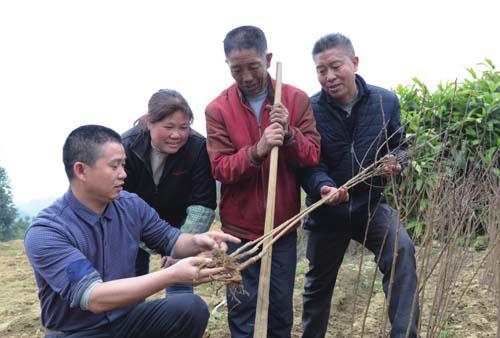An Aquatic Harvest
People harvest laver in the sun in Jiangshan Village, Putian in southeast Chinas Fujian Province, on October 24. Over 200 families cultivate laver at offshore marine farms in the village, harvesting some 133 hectares of the seaweed.
To the Rescue
China is set to transform its fi re services and armed forestry police into a national fi refi ghting rescue team, according to a new government plan.
Released by the General Offi ce of the Communist Party of China Central Committee and the General Offi ce of the State Council, the plan aims to improve the countrys disaster prevention, rescue and workplace safety, as well as to protect life and property and maintain social stability.
Specifi c management and safeguard measures for the team will be released and improved. After three years of trials, a mature policy system in line with laws and regulations will be formed.
“The forces and resources of emergency rescue should be optimized and integrated to give full play to the teams role as the main force in emergency rescue,” the plan stated.
A set of team management measures will set up an honor system to pay tribute to the fi refi ghting and rescue professions, and to establish a safeguarding system that fi ts the profession, according to the document.
Insurance Expansion
About 5.81 million rural families impoverished due to illness-related expenses have been lifted out of poverty since China initiated a new health insurance program in 2016, according to Wang Hesheng, Vice Minister of the National Health Commission.
In 2017, registered povertystricken patients only had to pay an average of 15.8 percent of their medical expenses, a decrease of 26.6 percentage points compared to 2016, Wang said at a poverty-alleviation forum in Beijing on October 18.
Since the initiation of the program, a total of 9 million patients in diffi culty have received targeted medical treatment.
A report released by the China Population and Development Research Center showed that as of 2017, 8.04 million out of 8.49 million impoverished patients had received medical treatment.
China views illness-caused poverty a great challenge and in 2016 issued guidelines on developing medical insurance programs in impoverished rural areas.
Pollution Alerts
Beijings environmental authority proposed scrapping the lowest blue alert for smog and relaxing the trigger for its orange alert, as the city has seen more clear days in recent years.
The current air pollution alert system was established in 2016. It is a four-tier color alert system, with red being the highest pollution level, followed by orange, yellow and blue.
The yellow alert and above will trigger a series of compulsory emergency responses including the suspension of construction operations, the restriction of heavily polluting vehicles or the suspension of production in smokestack industries.
The new plan also noted that regulators will make differentiated plans for different industrial enterprises to avoid a one-size-fi ts-all method in curtailing the output of polluting industries.
The average density of PM2.5, a major air pollutant, in Beijing in the fi rst seven months of this year was 55 micrograms per cubic meter, down 14.1 percent from the same period of last year.
In 2017, the number was 58 micrograms per cubic meter in Beijing, 20.5 percent less than in 2016.
Earthquake System
Chinas capacity in earthquake monitoring and disaster relief has improved over the past 10 years, said a report submitted to the National Peoples Congress, the countrys top legislature, on October 24.
The report was prepared after an inspection was completed on the enforcement of the Law on Protecting Against and Mitigating Earthquake Disasters, which was promulgated in 1997 and amended in 2008.
A new generation of earthquake monitoring and warning systems have been installed along more than 20 high-speed railway lines(spanning 6,642 km), said the report, adding that progress has also been made on a volcano monitoring system and a South China Sea tsunami warning center.
In terms of earthquake response, over 22,700 emergency shelters have been built and an earthquake rescue force of some 200,000 workers is on call for deployment.
To further strengthen the countrys earthquake response capacity, the report called for bigger investments in related technologies, stronger reinforcement of old buildings and better information sharing between agencies.
Narcotics Crackdown
An estimated 44 tons of narcotics were seized across China in the fi rst nine months of 2018, according to the National Narcotics Control Commission on October 23.
Police also detained about 94,000 suspects in 78,000 drugrelated cases in the corresponding period.
The country has seen positive changes in narcotics control with drug production contained, crossborder traffi c severely blown and the illegal production and distribution of precursor chemicals curtailed, the commission said.
Community correction programs for drug addicts also made progress. About 1.88 million former drug users have not relapsed for three years since rehabilitation, up 12.9 percent year on year, according to the commission.
Poverty Relief
Northwest Chinas Xinjiang Uygur Autonomous Region lifted nearly 1.85 million people out of poverty between 2014 and 2017, thanks to more supportive policies implement- ed in its southern poverty-stricken areas.
The regions poverty alleviation offi ce said that during this period, nearly 470,000 households of 1.85 million members cast off poverty, with the impoverished headcount ratio dropping from 22.84 percent to 11.57 percent.
Thanks to support from the Central Government, as well as other provinces and enterprises that have been providing aid for Xinjiang, the region has implemented a series of policies favoring the development of industries, rural tourism, education and healthcare in its southern areas.
In 2017, the region invested over 6.1 billion yuan ($879 million) in fi ghting poverty, with more than 80 percent of the investment going to four southern prefectures—Hotan, Kashgar, Aksu and Kizilsu Kirgiz—which sit on the edge of the Taklimakan Desert, the largest desert in China and the second largest shifting sand desert in the world.
In 2017, there were more than 1.33 million people living in extreme poverty in these areas. However, about 410,000 people of them are expected to be lifted out of poverty in accordance with a three-year plan.
Selfie Heaven
Visitors admire photographs taken by mobile devices displayed at the opening of Photo Beijing 2018 on October 20. The international event, which ran until October 29, featured a series of exhibitions, lectures, markets and special activities.
Public AI Platform
A national public service platform of artifi cial intelligence (AI) resources has been launched in southwest Chinas Chongqing, the Science and Technology Daily reported on October 22.
The data capacity of the platform will be no lower than 5 petabytes with an image recognition rate higher than 95 percent, a character recognition rate higher than 93 percent and a voice recognition rate higher than 97 percent, according to standards set by the National Development and Reform Commission.
The platform will have over 5 million items of standardized data, serving as a database for fi elds like fi nance, public security, intelligent manufacturing, smart education and social services.
It also promises to safeguard the security of information and data, be deeply integrated with the real economy and provide public services to benefi t peoples livelihood, said the newspaper.
Jointly built by Chinese tech companies CloudWalk, Baidu, Tencent and iFLYTEK, the platform has served more than 200 enterprises during its test operation period.
Tax Deductions
Chinese authorities on October 20 unveiled draft temporary measures on special additional deductions from taxable personal incomes to collect public opinions.
Chinas revised Individual Income Tax Law allows special additional deductions from taxable incomes for childrens education, continuing education, treatment for serious diseases, caring for the elderly, as well as repaying housing loans and rents.
The temporary deduction rules were made under the principles of being fair and reasonable, simple and easy to implement, effectively reducing peoples burdens and improving their lives, according to the Ministry of Finance and the State Taxation Administration.
For childrens education, 12,000 yuan ($1,729) will be deducted each year from the parents taxable income.
Rent deduction of up to 14,400 yuan ($2,076) each year will be granted to taxpayers who dont own any housing in the city where they work.
Blue Magic
A China-Belgium themed train featuring the characters from the Belgian comic The Smurfs is launched by Shanghai Metro on October 20 as a special service during the fi rst China International Import Expo.
Home Price Curbs
Home prices in major Chinese cities remained stable in September as local governments continued tight property curbs, data showed on October 20.
On a month-on-month basis, four fi rst-tier cities and municipalities—Beijing, Shanghai, Guangzhou and Shenzhen—saw both new and old home prices decline, the National Bureau of Statistics (NBS) said.
Prices of new commercial housing sales in fi rst-tier cities edged down 0.1 percent in September, compared with a 0.3-percent increase in August. Prices of existing home sales were also down 0.1 percent in the same month but stayed fl at in August.
New and existing home prices in second- and third-tier cities increased at a slower pace from a month earlier.
The total price increases in the fi rst three quarters of this year were slower than in the same period last year in all three tiers of cities and municipalities, NBS statistician Liu Jianwei said.
New home prices declined year on year in two of the 15 hotspot cities, where speculative home purchases are tightly monitored, while one city saw prices unchanged from a year ago and 12 posted growth, Liu said. To curb speculation, local governments have rolled out a spate of measures, including restrictions on purchases and an increase on minimum down payments for mortgages.
Internet of Vehicles
Beijing will promote the intelligent connected vehicle (ICV) industry and related industries, whose market value is expected to reach 100 billion yuan ($14.4 billion) by 2022, according to a white paper released by local authorities on October 21.
Beijing will advance innovation and research on ICVs to ensure they can be used for the 2022 Winter Olympics, said a white paper issued by the Beijing Municipal Commission of Economy and Information Technology on the sidelines of the World Intelligent Connected Vehicles Conference held in Beijing from October 18 to 21.
A 50,000-hectare pilot zone will be established and over 2,000 km of roads will be earmarked in Beijing for testing the ICVs.
The city will also accelerate construction of an intelligent traffi c system and the Internet of Vehicles.
The development of ICVs can improve traffi c safety, meet energy saving and emission reduction targets, eliminate traffi c congestion and bring social benefi ts.
FRUITFUL PLAN
Farmers plant cherry plums in Xinbao Village in southwest Chinas Guizhou Province on March 28. This year, farmers have extensively planted the fruit to generate more income and step out of poverty.
LNG Operations
A liquefi ed natural gas (LNG) terminal, invested by the ENN Group, a Chinese private energy company, began operations with the arrival of a ship loaded with 69,000 tons of LNG from Australia on October 19.
The terminal is in Zhoushan City, where the China (Zhejiang) Pilot Free Trade Zone is located. Its operations testify to the great potential in the oil and gas trade both at home and abroad for private companies.
The ENN Group invested nearly 7.7 billion yuan ($1.1 billion) in the project.
It also signed purchase contracts for around 1.75 million tons of LNG annually, according to Ma Shenyuan, the companys Senior Vice President.
Given the increasing global demand for energy, and great changes in the energy structure, more and more Chinese private enterprises are entering the global oil and gas market, Xu Xiaoyue, Vice Mayor of Zhoushan, said.
The private sector has gradually become a major actor in the domestic and global oil trading industry, contributing to innovation and development in the management of crude trading as well as ensuring the stable supply of domestic crude oil. Li Chenggang, Chinas Assistant Minister of Commerce, said this at the second International Petroleum and Natural Gas Enterprises Conference in Zhoushan on October 18.
Right on Track
A new freight route linking China and Pakistan is launched on October 23. The fi rst train departed from a logistics center in Lanzhou in northwest Chinas Gansu Province, bound for Kashgar in Xinjiang Uygur Autonomous Region. The goods were then transported to Islamabad by highway.
Reaping the Harvest
China is transforming its traditional agriculture sector, using science and technology to drive rural revitalization and modernization.
Delivering a report on the development of Chinas agricultural science and technology recently, Tang Huajun, President of the Chinese Academy of Agricultural Sciences, said remarkable progress has been made in innovation. It has played an important role in ensuring national food security and increasing farmers incomes.
According to the report, scientifi c and technological progress contributed to 57.5 percent of Chinas agricultural growth in 2017, in comparison with 53.5 percent in 2012.
Researchers have made several scientifi c and technological achievements since 2012, including cultivation and promotion of high-yield rice species and new genetically-modifi ed cotton species that resist insect. Highly effi cient vaccines for the deadly H7N9 bird fl u virus have been developed, the report said.
With diminishing availability of farmland, fresh water and other resources, science and technology is playing a bigger role in improving grain yields. Chinas grain output has been stable at over 600 million tons for each of the last fi ve years.
Tiger Soles
An artisan from Zoucun Village in north Chinas Hebei Province displays her handmade tiger shoes on October 22. Tiger shoes, recognized as intangible cultural heritage, provide a livelihood for more than 800 local women.
Share Repurchase Rules
A draft amendment of Chinas Company Law on share repurchasing was submitted to the top legislature for deliberation on October 22.
The Standing Committee of the 13th National Peoples Congress will review the draft, which aims to refi ne and improve the current share repur- chasing system.
Proposed changes include adding the circumstances of application, easing decision-making procedures and introducing information disclosure requirements for companies while reclaiming shares.
Under the current law, companies are forbidden from buying their publicly traded shares back except under four circumstances, such as granting employees equity incentives.
“The amendment is very necessary in that it will help companies establish a long-term motivation mechanism and improve the quality of listed companies,” Liu Shiyu, Chairman of the China Securities Regulatory Commission, said in his introduction to the amendment.
“It will also offer strong legal support for stabilizing capital market expectations under current conditions,” Liu said.
Analysts say stock repurchase operations could send a positive signal to the market and alleviate market jitters in cases of extensive underestimation of shares.

